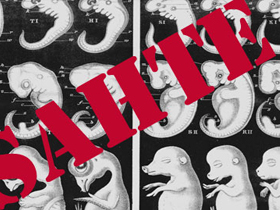Haeckel claimed that during their developmental phases, embryos repeated the evolutionary process that their alleged ancestors had undergone. For example, he maintained that during its development in the mother's womb the human embryo exhibited first fish-like gills and then reptile characteristics before finally "evolving" into a human baby. However, as time passed, it emerged that this scenario was totally imaginary.
Surely the biogenetic law [the recapitulation theory] is as dead as a doornail. It was finally exorcised from biology textbooks in the fifties. As a topic of serious theoretical inquiry it was extinct in the twenties.75
To support his theory of recapitulation, Ernst Haeckel produced faked drawings, attempting to portray fish and human embryos as resembling one another. When these frauds were exposed, he had no other defense other than to say that other evolutionists did exactly the same thing:
After this compromising confession of ‘forgery' I should be obliged to consider myself condemned and annihilated if I had not the consolation of seeing side by side with me in the prisoner's dock hundreds of fellow-culprits, among them many of the most trusted observers and most esteemed biologists. The great majority of all the diagrams in the best biological textbooks, treatises and journals would incur in the same degree the charge of ‘'forgery,' for all of them are inexact, and are more or less doctored, schematised and constructed.76
75. Keith S. Thompson, "Ontogeny and Phylogeny Recapitulated," American Scientist, Vol. 76, May/June 1988, p. 273.76. Francis Hitching, The Neck of the Giraffe: Where Darwin Went Wrong, p. 204.


